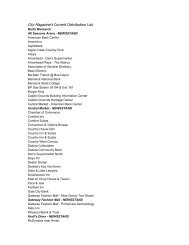Create successful ePaper yourself
Turn your PDF publications into a flip-book with our unique Google optimized e-Paper software.
|<br />
"Then you’d better start swimming or you’ll sink like<br />
a stone, for the times, they are a changing.”<br />
Yes, the times are changing in many<br />
respects. Oh, honestly, this is not a big<br />
one in the overall big picture. However,<br />
to many wine lovers this evolving change is long<br />
overdue.<br />
There are style differences between American<br />
and European wines; there are also other big<br />
differences, one in particular. When looking at<br />
a label, the American version will tell you what<br />
grape the wine is made from and the French<br />
version will tell you the region where the grapes<br />
are grown. It is one of those “centuries-old<br />
traditions” in wine that in the U.S. we luckily<br />
headed off at the pass and said “no.”<br />
After centuries of winemaking in France, they<br />
have determined that certain kinds of grapes grow<br />
best only in certain regions. Great.<br />
Then they went a step further. The<br />
government then basically made it illegal to grow<br />
any grapes in that region other than the chosen<br />
variety. (When I say “basically,” I mean that you<br />
can grow those “other” grapes, but have to label<br />
it as plonk. Oh, and “plonk” is not a good label to<br />
have.)<br />
In the U.S., when you pick up a “Chardonnay,”<br />
you know that the wine is made with at least<br />
75 percent of that grape. If you pick up a white<br />
Bordeaux, what kind of grape makes the wine?<br />
Well, you won’t get a Chardonnay from<br />
Bordeaux because the only white grapes allowed<br />
are Sauvignon Blanc and Semillon. If it is a white<br />
Burgundy, it is a Chardonnay. No Sauvignon<br />
Blanc allowed.<br />
The same thing goes if it is a French Chablis.<br />
(Different than a Burgundy, but the same grape.)<br />
A few more examples: In Bordeaux, the red<br />
grapes basically can only be Cabernet Sauvignon,<br />
Merlot, Petit Verdot, Malbec and Cabernet Franc.<br />
You can’t tell that on the label.<br />
In Burgundy, the red grape of choice is Pinot<br />
Noir. The Rhone region features many, including<br />
By Joel Gilbertson<br />
- Bob Dylan<br />
Grenache and Syrah on the red side and Viognier<br />
and Rousanne on the white side.<br />
After years of many people standing in wine<br />
shops and scratching their heads while looking at<br />
wine labels, things are finally changing a bit, and I<br />
think “we” are winning.<br />
Many of the Italian wines now show the grape<br />
variety and, shucks, even the French are slowly<br />
labeling some wines by the grapes that made<br />
them, rather than just the region. Change is slow<br />
but, in the wine business, as in many others, “The<br />
times they are a changing.”<br />
So, take a look at a French label, scratch your<br />
head, contemplate–and taste away!<br />
24 thecitymag.com
















